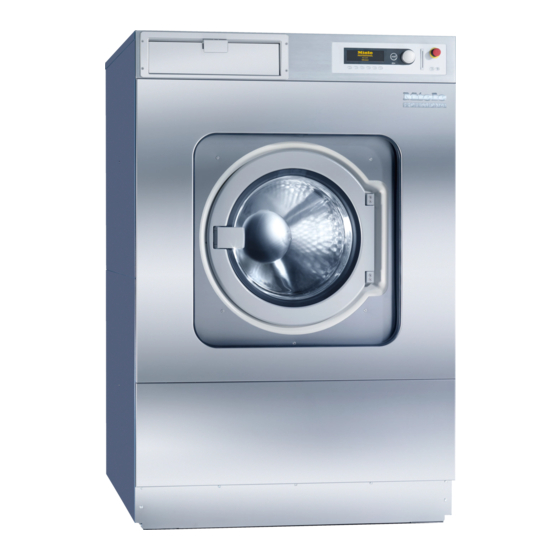Miele PW 6321 Operating And Installation Instructions - Page 6
Browse online or download pdf Operating And Installation Instructions for Washer Miele PW 6321. Miele PW 6321 44 pages.
Also for Miele PW 6321: Operating And Installation Instructions (44 pages), Operating Instructions Manual (46 pages), Programming Instructions Manual (48 pages)

IMPORTANT SAFETY INSTRUCTIONS
Additional information
~
Disinfecting and cleaning agents often contain chlorides
(salts) which can cause steel surfaces to rust. To protect
the machine from rust damage, only use chloride free disin-
fecting and cleaning agents for washing/disinfecting and
for cleaning the machine. If you are not sure about an
agent contact Miele's Professional Department. If you acci-
dentally spill an agent containing chloride on the machine it
should be rinsed off with water and dried with a soft cloth.
~
The manufacturer of the washer does not take responsi-
bility for the effect of the chemical on the laundry or the ma-
chine when a chemical cleaning agent is recommended on
technical application grounds.
~
Keep the area around the machine clean and free of de-
bris.
~
Before the appliance is removed for service or discar-
ded, remove the door.
~
The interior of the machine should be cleaned periodi-
cally by a qualified service agent.
Using accessories
~
Only use genuine Miele accessories. If other parts are
used, guarantee, performance and product liability claims
may become void.
6
Chlorine damage to components
How to handle chlorine bleach and perchloroethylene
(PCE)
~
Heavy use of chlorine products increases the risk of da-
mage to appliance components.
Depending on the chlorine concentration, the exposure
time, and the temperature, the use of liquid and powdered
chlorine-based bleaches can erode the stainless steel
protective layer and lead to corrosion of the appliance
components. Therefore, it is recommended that these
products not be used. Instead you can use oxygen-based
bleaches.
If you still need to use chlorine-based bleaches in special
cases, you will need to perform a neutralizing step each
time. Failure to do so can result in permanent and
irreversible damage to the washing machine and the
laundered items.
Chlorine neutralization
Chlorine neutralization must be done immediately following
the use of a chlorine-based bleach. For best results, use
hydrogen peroxide or an oxygen-based laundry soap or
bleach, without draining the tub.
If thiosulfate is used (especially with hard water), lime
deposits can form, leading to residue on the laundered
items or a build-up in the washing machine. The preferable
alternative is to use hydrogen peroxide, because it helps
promote the neutralization of chlorine.
The exact amounts to be used, and at what temperature(s),
should be selected based on the recommendations of the
neutralizer manufacturer, then checked for efficacy. The
laundry will need to be tested to ensure that no active
chlorine remains behind after neutralization.
SAVE THESE
INSTRUCTIONS
